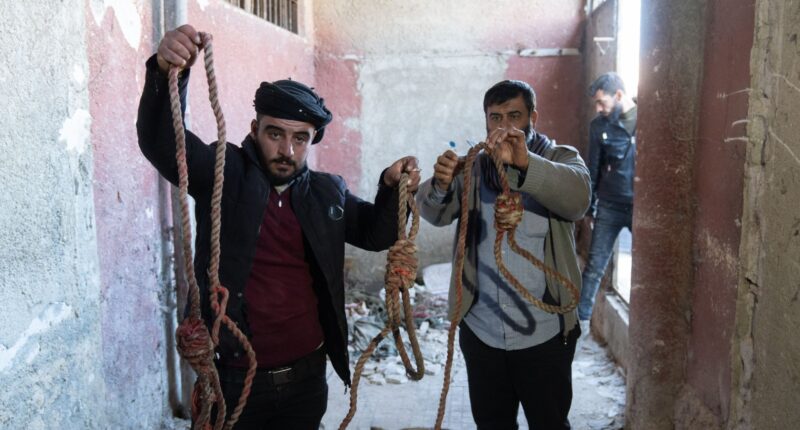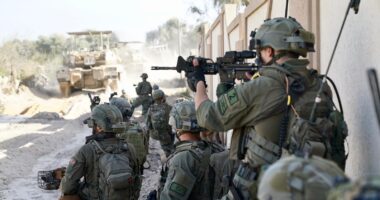The Syrian regime has been known for its brutal ways of governing the country, especially during the civil war, where it “disappeared” numerous individuals and exercised extreme control over the population.
But President Bashar Al-Assad’s dramatic toppling in December last year exposed the true horrors of his “human slaughterhouse” prisons.



A new BBC documentary sheds light on the horrific conditions inside the Syrian jails, where detainees were subjected to inhumane treatment including torture, assassinations, and mass burials.
This documentary not only features interviews with former inmates who survived these atrocities but also gives a voice to the perpetrators who carried out these disturbing actions.
“When the prisoners heard my name, they would tremble,” said Hussam, a military policeman who worked in the notorious Saydnaya Prison.
“I beat them with all my strength. I showed them no mercy at all.”
With the dictator gone, outsiders were free to explore the labyrinth of concrete corridors that only a few months before were filled with the echoing screams of gaunt prisoners.
The floors were littered with files and photographs of detainees – some partially burnt in an attempt to cover up the crimes – just part of the meticulous records kept by the state of everyone who passed through the prison walls, their names replaced by a number.
Families of the missing and imprisoned are seen in the documentary desperately crawling over rubble hunting for a trace of their loved ones – or at least the truth about what happened to them.
Since 2000, dictator Bashar Al-Assad presided over a Syria where dissent was crushed and human rights abuses were rife.
Crucial to his hold on power were his security services, who showed little mercy to prisoners accused of threatening the regime.
“As security officers we had the right to kill as we please. We wouldn’t be held accountable,” said Colonel Zain, a former Air Force Intelligence officer interviewed on the documentary.
“[Our] mission, like any other agency, was to protect the ruling regime. You have unlimited authority.”
To them, these were terrorists – and death was the least they deserved.
In 2011, protests in Tunisia turned into a call for better human rights across the Middle East and North Africa, a movement called the Arab spring.
But when those protests swept into the squares of Syria’s capital, Damascus, they were met with a fierce crackdown.
Instead of toppling Assad, the country was plunged into a brutal civil war as different factions wrestled for control.
During the 13 years of fighting, more than one million people were detained by the regime.
Street kidnappings



Shadi Haroun was one of the first organising protests back in 2011, along with his brother Hadi.
After dodging shots from snipers on rooftops, he was bundled into a car and taken to what looked like an ordinary house in the suburbs of Damascus.
But this was no home. It was an interrogation centre – and Shadi was to get his first taste of the Assad regime’s determination to stamp him out.
“The soldier told me to open my mouth,” Shadi recalled. “He put his gun inside, and said: ‘You’re going to get tortured to death. So why don’t I make it easier and put you to rest?’”
Soon after he was transferred to Mezzeh Air Force Intelligence base, one of the regime’s most notorious detention sites.
Like all those who opposed Assad, Shadi was deemed a terrorist – with torture their chosen method of extracting a confession.
“He called the investigator and said to him, ‘This man, flay him and break his bones. Kill him, do whatever you want, but I need his confession on my desk’,” said Shadi.
This man, flay him and break his bones. Kill him, do whatever you want, but I need his confession on my desk
Security official
“He told me to lie down. They handcuffed my hands behind my back, and then cuffed my feet and joined my hands and feet together.
“They wrapped me in a blanket, like being inside a pipe. I was sweating and the smell of blood was very strong. I stayed wrapped like that for about a week.”
Eventually Shadi was released. Undeterred, he began organising protests again, more determined than ever to bring down the regime.
Carpet of bodies



Within nine months of the protests, thousands had been arrested, many bundled off the streets like Shadi and taken to secretive locations where they were tortured until they ‘confessed’.
At least 3,000 had already been killed.
Syria’s security forces had a network of spies and informants across the country that tracked people like Shadi’s every move.
“You could find informants wherever you go,” said Sergeant Omar, an officer in the Air Force Intelligence.
“They could be a taxi driver, they could be a plumber, a mobile phone shop owner, a guy selling cigarettes.
“People were living in fear. This is why we’d say, ‘the walls have ears’.”
It wasn’t long before soldiers pulled up to the house Shadi and his brother were hiding in.
Arrested once again, they were taken to the notorious Air Force Intelligence branch in Harasta, on the outskirts of Damascus.
Those who entered would walk over the bodies of the detainees – you couldn’t see the floor
Colonel Zain
Colonel Zain was second in command at the time.
“The place I worked in was very famous for its bloody practices and the number of detainees held there,” he said.
“We would pack 400 detainees in a room that was eight by ten metres. Those who entered would walk over the bodies of the detainees – you couldn’t see the floor.”
Shadi returned to Harasta with the documentary crew and showed them round the bare walls that once imprisoned him.
“The temperature was around 40 degrees, because it was so crowded,” said Shadi.
“We saw strange cases of disease amongst prisoners, I think due to oxygen deficiency because of overcrowding. These psychotic episodes soon turned into physical symptoms.”
‘Torture parties’



Inside is a changing room, where inmates were stripped, and solitary confinement cells where prisoners would spend months, or even years, locked up.
In a neighbouring room, Shadi is reminded of when he was chained up with his brother before being interrogated from pipes on the ceiling.
“We were taken there and hung by our handcuffs from the pipes,” he said. “It was unbearable – for almost 72 hours, three days, in the same position, without food or drink.”
Colonel Zain recalled: “The interrogation room was right underneath my office.
“Everyone heard the screams. Everyone knew how the interrogations were conducted.”
Four months into their detention, a truck pulled up that was normally used to transport meat and they were moved to Saydnaya, a prison with a reputation for brutality that preceded anywhere else in the country.
Brainwashed guards treated prisoners like animals, subjecting detainees to continuous beatings.
“We were tortured for hours, and stopped keeping track of time,” recalled Hadi.
“If someone cried during a beating, the beating would get worse.”
Torture them, don’t let them sleep at night. Throw them a party… put them in a grave if you want to, bury them alive
Intelligence officer
Putting his arms up against a door, Shadi said: “They’d bring a cable and suspend us like this. This is the ‘Ghost Method’.
“They’d pull us up and we’d be on our toes – you’d last 30 minutes then you’d pass out.”
Up to 13,000 prisoners were executed here alone in the first four years of the civil war, according to Amnesty.
“I beat them with all my strength,” said Hussam, a military policeman.
“Our superiors would say, ‘Torture them, don’t let them sleep at night. Throw them a party… put them in a grave if you want to, bury them alive’.
“When they’d call me to go and torture them, the prisoners would go back to their cells bloody and exhausted.”
‘Execution parties’


Occasionally a prisoner would be dragged out of their cell, finally receiving a respite from the torture.
But they were on their way to a secret trial – and death was the usual sentence.
“On Wednesday mornings, we’d have an ‘execution party’,” Hussam recalled.
“Our role during executions was to place the rope on the prisoner – only an officer could push the chair.
“One time, the chair was pushed, but after 22 minutes he didn’t die. So I grabbed him and pulled him downwards, so another guard who was bigger and stronger said, ‘Go I will do it.’
“Before he died he said one thing: ‘I’m going to tell God what you did’.”
The bodies of the dead – be it from execution, torture, or disease – were then taken to military hospitals where their deaths were registered.
“Most of the bodies suffered acute weight loss, resembling a skeleton,” said Kamal, an army nurse.
“Most of them suffered from skin lesions and rashes due to lack of hygiene – and most of them had torture marks.”
He added: “It was forbidden to record the cause of death as torture. Even those killed from gunshots were recorded as heart and respiratory failure.”
All the decision makers who had a role in oppressing the Syrian people escaped, and are now in hiding
Shadi
With the bodies piling up, mass graves were the only solution.
At least 130 grave sites have been found across Syria so far – but dozens more are believed to be out there, known only to those who dug them out.
There is little hope of identification for the thousands dumped there.
Many of the guards and officers defected from Assad’s regime, joining the rebels or fleeing the country.
By 2019, the rebellion had largely been suppressed.
Shadi and his brother were released at last, fleeing to exile in Turkey.
Then, in December this year, rebel forces overwhelmed Damascus and Assad fled the country and claimed asylum in Russia.
With the collapse of the regime, Shadi set to work helping others locate their missing friends and family.
But for many there is little hope of ever finding out what really happened to them.
“Everyone, the detainees, and families of the missing, should keep talking about this,” he said.
“All the decision makers who had a role in oppressing the Syrian people escaped, and are now in hiding.
“They’ve left everybody to pick up the pieces – to deal with what they left behind.”
Surviving Syria’s Prisons airs tonight on BBC Two at 9pm.

















